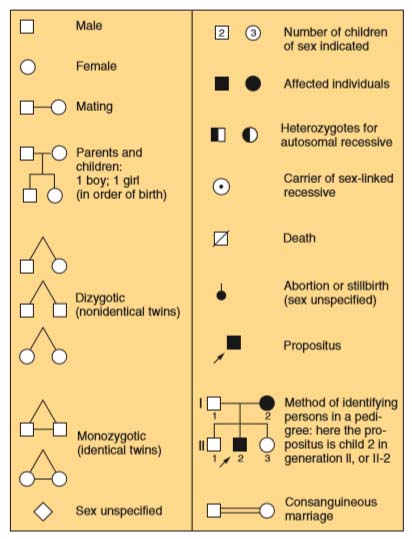Human matings, like those of experimental organisms, show many examples of the inheritance patterns described above. Because controlled experimental crosses cannot be made with humans, geneticists must resort to scrutinizing records in the hope that informative matings have been made by chance. Such a scrutiny of records of matings is called pedigree analysis.
A member of a family who first comes to the attention of a geneticist is called the propositus.
Usually the phenotype of the propositus is exceptional in some way (for example, the propositus might suffer from some type of disorder).
The investigator then traces the history of the phenotype in the propositus back through the history of the family and draws a family tree, or pedigree, by using the standard symbols

Phenylketonuria: PEDIGREE ANALYSIS OF AUTOSOMAL RECESSIVE DISORDERS:
PKU is a disease caused by abnormal processing of the amino acid phenylalanine, a component of all proteins in the food that we eat. Phenylalanine is normally converted into the amino acid tyrosine by the enzyme phenylalanine hydroxylase:

However, if a mutation in the gene encoding this enzyme alters the amino acid sequence in the vicinity of the enzyme’s active site,the enzyme cannot bind phenylalanine (its substrate) or convert it to tyrosine. Therefore phenylalanine builds up in the body and is converted instead into phenylpyruvic acid. This compound interferes with the development of the nervous system, leading to mental retardation.

The affected phenotype of an autosomal recessive disorder is determined by a recessive allele, and hence the corresponding unaffected phenotype must be determined by the corresponding dominant allele.
For example, the human disease phenylketonuria (PKU) is inherited in a simple Mendelian manner as a recessive phenotype,with PKU determined by the allele p
and the normal condition by P.
Therefore, sufferers from this disease are of genotype p/p,
and people who do not have the disease are either P/P or P/p.
What patterns in a pedigree would reveal such an inheritance?
The two key points are that
(1) generally the disease appears in the progeny of unaffected parents and (2) the affected progeny include both males and females. When we know that both male and female progeny are affected, we can assume that we are most likely dealing with simple Mendelian inheritance of a gene on an autosome, rather than a gene on a sex chromosome. The following typical pedigree illustrates the key point that affected children are born to unaffected parents:

From this pattern, we can deduce simple Mendelian inheritance of the recessive allele responsible for the exceptional phenotype (indicated in black).
Furthermore, we can deduce that the parents are both heterozygotes, say A/a; both must have an a allele because each contributed an a allele to each affected child, and both must have an A allele because they are phenotypically normal. We can identify the genotypes of the children (in the order shown) as A/-, a/a, a/a, and A/-. Hence, the pedigree can be rewritten as follows:
